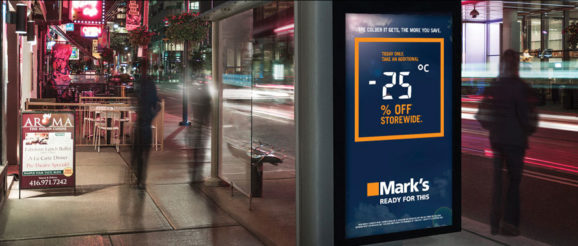Astral’s creative approach to innovation

Approximately 10% of Astral’s inventory is digitized, but more traditional signage is converted every day. This allows for better creative campaigns and better data to measure effectiveness.
Much has changed in out-of-home media over the last few years. The industry has gone digital, audience data has become a huge priority, and what was once a purely traditional format has become a technological arms race.
But for Astral, one idea steers the company through this disruptive time: creativity breeds success.
“Creativity is the content of our business,” says Karine Moses, president of Astral. “It shapes everything we do. It’s the fuel of our business.”
This will ring true for anyone who’s seen the company’s Carte Blanche competition, which just completed its ninth annual contest. It judges competitors from the creative side of the industry on the strength of the ideas they design for Astral clients using its networked inventory.
But creativity goes deeper than what appears on billboards and digital screens, Moses says. It means new ways of thinking about out-of-home, trying new things and utilizing every advantage to deliver big ideas to clients.
In February, for example, that manifested as a cross-platform integration for automaker Infiniti. In Toronto, Astral worked with Bell Media radio stations CHUM FM and Virgin to coordinate ads appearing on highway billboards with radio spots airing in the cars that drove by – a new product called From Radio To Road. So as a Bell Media radio listener commuted to work in the morning and heard an Infiniti ad, the roadside digital boards would receive a signal to display Infiniti campaign creative for that model.
Another recent campaign for a line of beard care products relied on facial recognition software to identify when a bearded person was within view of a given facing. Only then would it call up the campaign’s creative, ensuring it reached the target consumer.
Creativity and tech are clearly linked, so Astral has invested in being at the forefront of innovation. That’s no small commitment at an organization as far-reaching as Astral’s – it has 31,000 facings in five provinces that fall into five main lines of business: outdoor, large-format digital, street furniture, airports and transit.
Ten per cent of the company’s facings are currently digital, but the push is on to convert more static inventory to connected, adaptable, data-rich media. Moses says it’s her goal is to double that percentage in as short a time as possible.
While digital signage offers more to advertisers in terms of the types of ads they can develop, a connected digital board allows for the collection of better audience data – a major priority for Astral.
In December, Astral launched a self-serve programmatic offering through a partnership with Hivestack. Advertisers can now conduct automated buys against more than 120 large-format Astral digital boards in five major cities, with more inventory to become available as Astral conducts its digital transformation.
“It’s a new way of selling and doing business in out of home,” Moses explains. “Our focus when it comes to innovation is to drive attribution and results.”
But Moses says that as essential as technical innovation is to media creativity, that investment must be matched by an investment in talent. “We want to diversify the skill sets we have in-house,” she says. That means bringing in leadership not just from other parts of Canada’s media industry, but from other industries altogether. For example, TV buying experts have arrived from media agencies, code specialists have arrived from the online world and a number of operational experts have all expand Astral’s expertise.
Regardless of where technology steers the industry next, Moses says she knows Astral can stay ahead of the curve.
Beneath its deepening technology credentials and diversifying skill set is Astral’s philosophy that creativity is the key to staying relevant. It seeks out new ideas, forges new partnerships and engages Canadians in new ways.
“Astral’s business is the creativity business,” she says. “That’s what’s made us successful so far. And I don’t think that will change, no matter where the industry goes next.”
